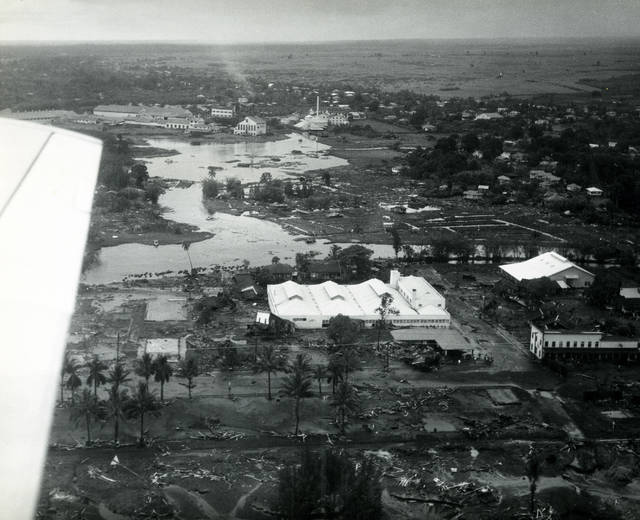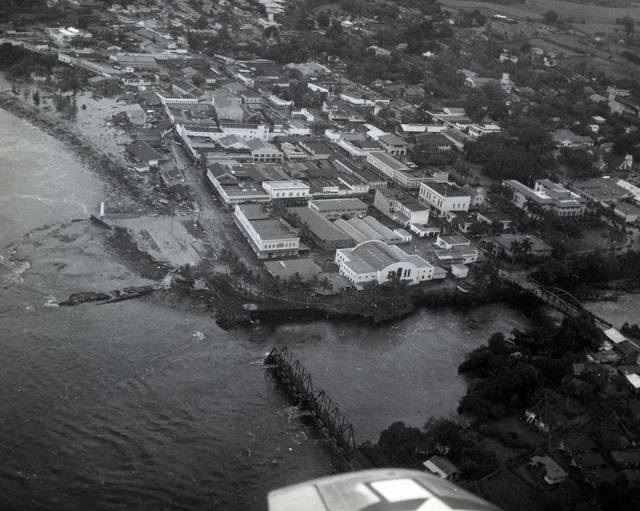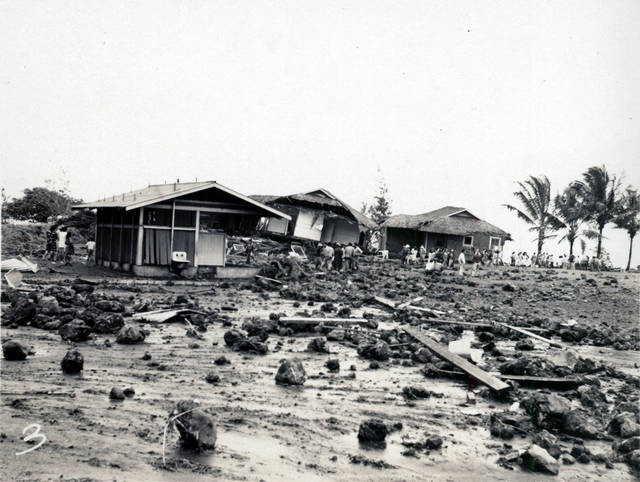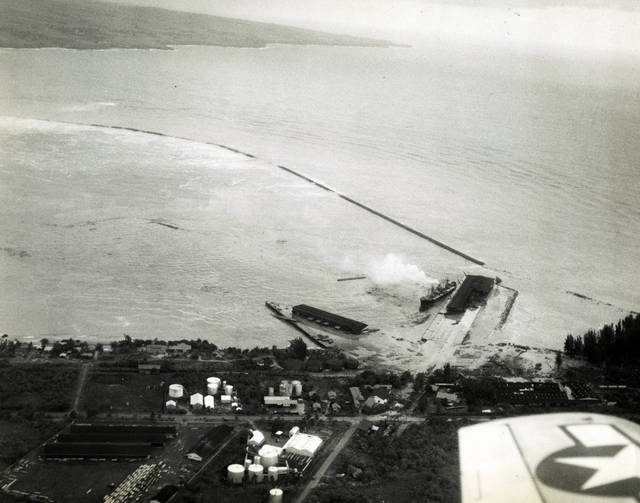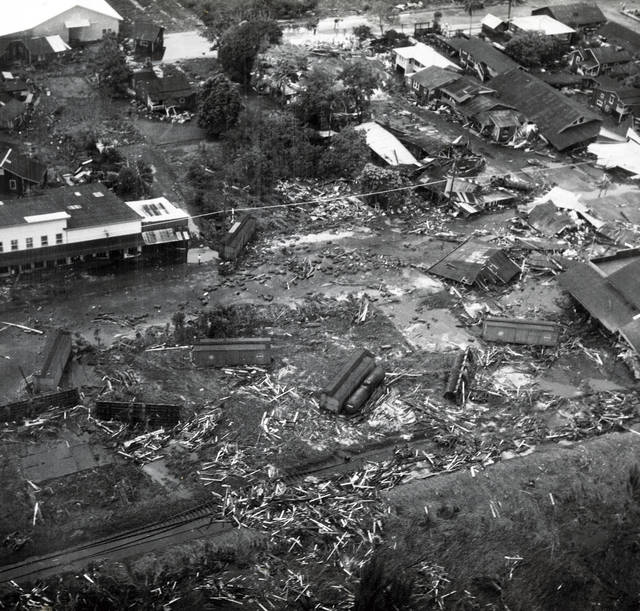Waves of memories: Stories paint picture of what it was like to experience 1946 tsunami
Editor’s note: Today marks the 71st anniversary of the April 1, 1946, tsunami that killed 160 people and caused widespread damage in East Hawaii.
ADVERTISING
People learn from the stories of others.
At the Pacific Tsunami Museum, we tell stories in our exhibits on touchscreen computers, in our vault video, in our printed displays and in our presentations. We hope to increase awareness so people make informed decisions in the event of another tsunami.
The 1946 tsunami was generated by a magnitude-8.6 earthquake in the Aleutian Islands. It took five hours for the waves to reach the Hawaiian Islands. Unfortunately, there was no warning system at that time. There was devastation to homes, schools and businesses in Hilo and elsewhere, to the piers at the Port of Hilo, and to the railroad track and train cars.
Rather than describe the aftermath, I will tell stories to paint a picture of what experiencing it was like.
1. What happened in Shinmachi by the Wailoa River?
Hiromi “Skeeter” Tsutsumi grew up on the banks of the Wailoa River in the close-knit community of Shinmachi. On the morning of April 1, 1946, Hiromi heard his sisters yelling, “Tidal wave!” He smiled and replied, “April Fool,” but then he saw water rising in their yard and houses floating up the river.
The Tsutsumi family sought refuge in the two-story cement Coca-Cola building. Fortunately for Shinmachi residents, the plant manager came to work one hour early that morning.
The Coca-Cola plant survived the impact of the waves, although the district around it was largely destroyed, and surrounding buildings came to rest against the plant. The plant had afforded a safe haven for more than 130 people.
When the waves finally stopped, the Tsutsumi family found their home was gone.
2. What happened to the railway station by the Wailuku River?
In 1946, Ernie Kurohara was on his way to Hilo Union School to do his duty as a JPO — junior police officer. He noticed a lot of commotion by the bay, so he and some other JPOs ran down to the area by the mouth of the Wailuku River.
There were people telling them not to go any farther, but boys being boys, they just went down as far as they could.
Ernie says the first two waves weren’t that big, but before the third wave, the water was sucked out of the bay and they could see fish flopping around. Then, he said, “all of a sudden, when you looked at the horizon, you saw the water just piling up and there was a huge wall, and the wave started to come back.”
Ernie and everybody else ran, but he turned and witnessed the tsunami’s destructive power as the wave smashed into the railway station and destroyed it.
3. What happened at the Hilo pier?
Tuck Wah Lee, a worker at the pier, reported to work to unload lumber from the ship Brigham Victory. As he talked story with fellow workers, someone yelled that the ocean level dropped.
Everyone rushed out to look, some even picking up fish. Tuck Wah Lee climbed the Coast Guard tower for a better look.
As he started his descent, he saw a brown wall of water advancing, getting larger as it approached. He yelled “Run!” and dodged into the pier warehouse, jumping up a ladder to the rafters. A giant wave surged through the building just below him, and he saw bags of sugar floating as a small barge crashed through the building.
When the water level receded, he knelt and said a prayer. He climbed down the ladder and decided the safest thing might be to swim out to the Brigham Victory, now about 40 feet from the dock.
He leaped into the swirling, receding water and swam through debris to the ship, climbing onboard just before another wave smashed the warehouse and washed the ship’s gangplank away. The ship made it safely out to sea. The breakwater had gaps where boulders were washed from it by the waves, deposited on shore.
4. What happened on Kamehameha Avenue in Hilo?
On April 1, 1946, Bill Jensen drove from North Hilo into Hilo town. He observed a section of the railroad bridge by the Wailuku River was washed out.
Not knowing more waves were coming, he drove along Kamehameha Avenue just adjacent to the ocean. However, his path was blocked by scattered lumber, so he turned and drove inland, an action that saved his life.
5. What happened in Keaukaha?
The Nakagawa family operated the Seaside Restaurant in Keaukaha. They had no idea that before the day was finished, they would lose their restaurant and their homes nearby.
Larry Nakagawa just got up and was washing when he heard a strange noise. He says it was “like if you were to take a bucket of pebbles and throw it on the concrete.” He rushed outside with his father, brother and uncle. They saw the water surging, and Larry’s older brother said they should all climb trees.
Larry was about 15-20 feet up a tree, along with his brother and dad. His uncle was on another tree. Soon, Larry saw a wall of water coming.
He said, “I looked back because our home was now pushed to the back of us and we were facing the ocean. I could see a wave come and push the building right down into the pond and wash it in. Just like a matchbox … .”
The restaurant and their homes were now wreckage in the pond. In the following days, they salvaged what they could.
“We had a big raft made,” Larry recalls, “and we went all the way in the back of the pond to look for our things.”
They found dishes, photos, furniture and even bottles of soda they opened and drank.
6. What happened at Laupahoehoe?
Laupahoehoe Peninsula, located 23 miles north of Hilo, was an idyllic place to attend school. Tragedy would unfold when tsunami waves took the lives of students and teachers.
Joretta was usually on campus by 7 a.m. She would wait for her friend, Janet Decaires, to arrive and they would walk down to their oceanfront teacher’s cottage to sit. However, on April 1, 1946, Joretta’s mother insisted Joretta stay home to practice piano before going to school. After practice, her father drove her to school, and at the lookout they found that cars were driving up and people shouting, “Big waves!”
They saw a wall of water envelop the point, and the ocean made a roaring sound. The teachers’ cottages were demolished, swept from their foundations. Tragically, Joretta’s friend, Janet, who was waiting on the back step of the teacher’s cottage, was swept to her death.
Joretta’s life had no doubt been saved by the fateful act of staying home to practice piano.
Barbara Muffler is archivist/curator at the Pacific Tsunami Museum in downtown Hilo. She is the author of “Hawai‘i Tsunamis (Images of America).” The museum is having an open house today from 10 a.m. to 4 p.m. Muffler and a number of other guest speakers will be there to share stories and information about tsunamis. Admission is free.



